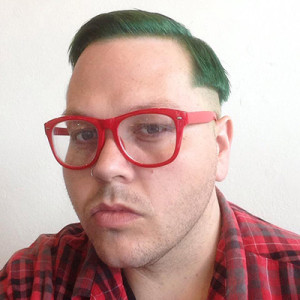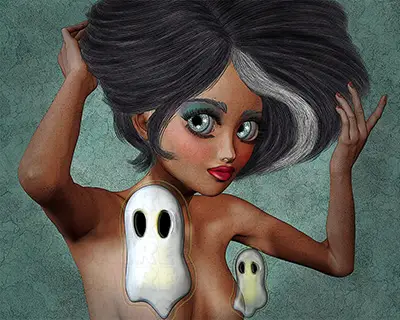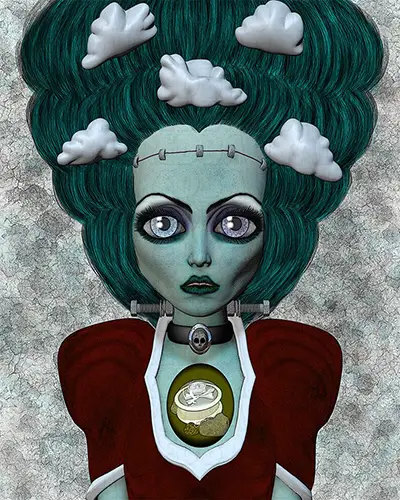 Baub Alred is a digital artist from Champaign, Illinois, United States of America. In this interview he talks about his art projects and the trends and movements that have influenced his work.
Baub Alred is a digital artist from Champaign, Illinois, United States of America. In this interview he talks about his art projects and the trends and movements that have influenced his work.
Art has been your passion for a long time. How did it all start?
I always loved creating, but 7 or 8 is when I can actually remember practicing to draw. I always wanted to be a comic book artist, so I would draw the images from my X-Men comics. After a few years of comic drawing, I started trying to recreate horror movie scenes. I think this is where my style was born.
When did you make the transition to digital creations?
In 1997, this was a year that I jumped into digital creations. I purchased my first digital camera, which held a total of 8 or 12 images. I learned HTML and would create digital stories on the web. I made images with the use of the pictures I took with the digital camera (edited with Photoshop) and there were objects on each web page that a person would click to take them to the next image in the story. I wish I still had these!! It would be amazing to see what I did then compared to what I can create now.
What software are you using and what’s the process involved in creating a piece?
I use Poser, Sculptris and Photoshop. Typically, I start by creating skin maps in Photoshop. I build them from stock maps, specific to the 3D model that I am using. Then, I use Poser to add the maps to the model. The models are basic forms that, through the additions of morph forms, I can adjust the bone structure and body shape. After the map is applied and I am happy with how the model looks, I pose the model. Next, I will use Sculptris to create clothing and, more recently, ghosts. After I pull in objects created in Sculptris and the scene is set, I adjust the lighting of the scene and “camera” view in Poser. The scene is then rendered in Poser and exported to Photoshop. In Photoshop, I digitally paint over the render to get the hair, makeup, textures, effects that finish the image.
Which artist influenced you the most in your career?
Caspar David Friedrich had the biggest influence on me. Even though our art is leaps and bounds away from each other in technique and content. The underlying sadness and isolation in his work, greatly impacted me.
Your Abandoned Plot series has some really poignant compositions. What gives you inspiration for this series?
I love anything horror and supernatural. I draw inspirations from those genres while applying person experiences and beliefs. I feel that I create images with a “fun” vibe to them. A lot of people see that as face value and don’t see that most of my images come from a depressed and sad place. Sadness and depression can spawn some of the most beautiful images and creations.
The Big Eyes series takes a lot from the late 50’s and early 60’s art scene. Do you think people in this new millennium connect with this art form?
I do, but I believe they are unaware as to why it connects to them. The 50’s and 60’s Big Eye movement has had a lot influence on a lot of people, but Anime is an area that reflects this the most. With the popularization of Anime in the late 80’s in America, it’s major influence on the cartoons and Manga’s influence on American comics, it has made its way back into the art world. There are so many artist creating Big Eye, Anime and Manga inspired art today.
The Fashion Masks series gave me an eerie feeling. What’s the message there?
This series was created for a show with my artist friend, Sophie McMahan. It was a Halloween themed show and I really wanted to show a beautiful side of the Halloween/Horror genre. I created the series based on vintage Halloween masks made by Collegeville or Ben Cooper. I wanted to portray them masks as full-bodied characters that were modern fashion models. I think the eeriness comes from the broken posing and vacant stares.
You’re such a passionate artist, but can a digital artist make a living solely from his work?
Absolutely, but the statistics are not in any artist’s favor. Art is subjective at best, for every one hundred people, one person may like your art. Chances are that one person is not in the market for a wall hanging art. This is why a lot of artists market their images into more affordable/accessible products, such as prints, t-shirts, key chains, phone covers. Luckily, we as humans are connected to each other through the web.
What’s the role of social media in the life of an artist today?
Social Media is everything! The internet was great for artists. I have had my art on the web since 1997. But, social media has taken it to a whole other level. I started my Facebook art page, in 2009. I thought it would just be comments from family and friends, but soon I would get likes from people around the world. That still amazes me. Some artists think locally, in today’s world, you have to think globally. Also, I think it is very important for you to be found. That is why all my social media accounts are my name. So, you can find me on Instagram and Twitter under “baubalred”.
What are the plans for the future? Any possibility of a show?
I am continuing with my Abandoned Plot series. I have submitted to galleries in and out of my area, so hopefully something comes of that. I would love to have another show with Sophie McMahan. We were just talking about very recently. We had such a blast and everyone had a lot of fun!


